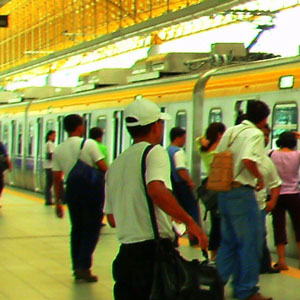Having to protect four malls, three busy MRT stations, a business district and the rest of the city’s population that balloons to at least three times its normal size during weekdays is a task that is not for the faint of heart.
Securing one of the biggest shopping malls in the world and another one known for its being the choice shopping and leisure destination of not just tourists but the who’s-who in the country makes this mission even more unenviable and daunting.
Aside from being the mall capital of Metro Manila, Mandaluyong is also recognized as the center of the National Capital Region.
Accessible to nearly every major city in the capital with boundaries in Makati, Pasig, Quezon City and Manila, this city may be the envy of many neighboring localities who may wish of having the same blessings.
However, Mandaluyong Mayor Benhur Abalos sees both sides of the situation. Though he knows his city’s advantages as a location for business and investments, the mayor is also very much aware of the risks it faces in being very accessible.
But Abalos is not one who will drop the ball on a challenge.
Though others may see him as lucky for having a major portion of the other major central business district in the metropolis that is the Ortigas Center, Abalos is painfully aware of the humongous security challenge that this blessing carries with it.
Aside from the malls, Mandaluyong also has in its territory the often-congested San Juan-bound flyover at the corner of EDSA and Ortigas Ave., the other end of the fragile Guadalupe Bridge and three busy stations of the MRT, among others.
Abalos also showed his resolve to protect vital installations in the city when he blocked the construction of an 85-storey mixed-use condominium located on a property near one of the foundations of the Ortigas station of the MRT.
Allowing the construction to push through, according to City Hall, would not only have violated the city’s zoning ordinance, but would have endangered the foundation of the Metro Rail Transit (MRT) at the corner of EDSA and Ortigas that may lead to its collapse and worse, the loss of lives.
The planned structure was also rejected by the community surrounding it. Thus, it was not given a barangay clearance—a pre-requisite to the application of a city hall permit. The case is currently pending before the Supreme Court.
While awaiting the decision of the High Court on this issue, the city faces a critical threat that is perpetually posed by the 50-foot deep pit that was supposed to host the 85-storey structure. Many fear that unless it is finally covered with earth, this deep hole will continue to be a big threat to the MRT foundation and to EDSA and Ortigas avenues as well.
Only a few many remember that back in 1996, San Miguel Avenue’s portion connected to Shaw Blvd. caved in during the construction of the One San Miguel Place building. The road’s collapse has long been fixed, but the lessons must never be forgotten as this may be repeated.
In this day and age when terrorists with powerful bombs and criminal gangs with sophisticated firearms can strike at any time, ensuring the safety of the structures and the public who use these is a hellish task that cannot fail.
These structures and installations with the heavy pedestrian and vehicular traffic that they carry regularly are indeed a very tempting target for groups who want to make a statement or catch the public and the government’s attention.
Learning from the experience of the SM Megamall bombing some 10 years ago during his first term in office, Mayor Abalos says the city has learned a lot from that experience.
“We have our goals as far as security is concerned, but we also have to take into consideration that every plan to ensure peace and order in the city especially in the business district should always consider the factor played by the private security providers—the security agencies that cover the different establishments and structures in the area,” the mayor told Security Matters in a recent interview.
So what the city did is to ensure that every development in its security program for the city and the Ortigas Center will always include a seminar to reorient the security personnel of the different establishments and malls in this area.
City Police Chief Sr. Supt. Carlos de Sagun, for his part, cited the role of the private security providers in supplementing the capability of the police force.
“The communication lines must always be open and we should always make sure that the private sector is always involved in every security plan for the city no matter if it is in a residential or commercial area,” de Sagun stressed.
For the commercial areas, the city has required the installation of security cameras in strategic areas along with constant coordination with the security teams of the malls and other establishments in these areas to ensure that the police will always have their eyes and ears in all critical areas of the city.
“We also have regular 24-hour patrols that are done together with the different communities of the city. The patrols include the different barangays, their officials, tanods and even private residents just to make sure that all bases are covered always,” de Sagun noted.
He also disclosed that the Mandaluyong police regularly visits all of the city’s banks with every visit recorded in the security guard’s log books just to make sure that the critical security areas and establishments are always monitored.
Mayor Abalos, on the other hand, disclosed that the city recently purchased 10 new Toyota Innovas for the police to improve their mobility.
The new vehicles will help in improving and ensuring regular and increased police visibility in all parts of the city.
The city currently has an estimated 350-man police force that is tasked with guarding a daytime population of around 300,000 or more.
“We have so many vital installations in our city. Aside from the commercial areas, we also have the headquarters of Globe, offices of PLDT, the MRT, and a Meralco substation, among others, that keep us always on our toes as one security lapse may be taken advantage of by undesirable elements and may lead to chaos,” the police chief pointed out.
De Sagun cited the city policy of requiring banks to install CCTVs with better resolution to assist in securing critical security areas in the city and in the solution of crimes.
“Did you know that many of the crimes solved by the police were helped greatly by the CCTV cameras as these allowed us to identify criminals, most of whom already had criminal records in the past, and to locate their whereabouts?” he said.
De Sagun cited the murder of an executive of one of the largest pharmaceutical companies in the country whose headquarters is located in the city.
“After seeing the crime scene and discovering that the victim’s ATM card was missing, we immediately monitored the transactions and learned that it was used in a ATM terminal located near the office of the victim, and because of the CCTV camera located in the ATM terminal, we managed to pin down the suspect who turned out to be his driver,” the police chief said.
“We conduct checkpoints at random every night to provide surprises and avoid becoming predictable,” he explained.
These steps and security programs taken by the city, he claims, are very effective as the crime rate has been very low though he wasn’t able to come up with figures during the interview.
“We also regularly monitor the cases filed against criminal elements whom we have apprehended and we make sure that these are attended to. We don’t consider a case closed as long as there is no conviction handed down yet. This is entirely different from the old practice wherein the mere apprehension of a suspect already merited a ‘case-closed’ tag,” de Sagun stressed.
The city police, he added, also monitors the MRT stations in the city and regularly coordinates with the security of this vital installation as a deterrent to any group who may have bad intentions.
Though the busiest MRT station is said to be the one in Cubao, Quezon City, the presence of the Asian Development Bank headquarters near two of the three stations in Mandaluyong is another reason for the city’s police and local government to stay on its toes and to never let its guard down.
One of the Manda-based stops of the metro rail is even located right outside the perimeter wall of the ADB headquarters located on a property sandwiched by EDSA and ADB Ave., Ortigas Center.
The presence in its backyard of one of the largest financial institutions in the world, though it adds prestige to the address, is one huge responsibility that the city cannot overlook or ease up on as one wrong or missed step may lead to problems or damage to property and public confidence and if luck totally runs out—the loss of life and limb. •
The city police, de Sagun disclosed, also puts up regular chokepoints in the city’s boundary areas just to make sure that criminal elements are always kept out and to see to it that criminal elements would avoid passing by the city and use it as a transit option.






